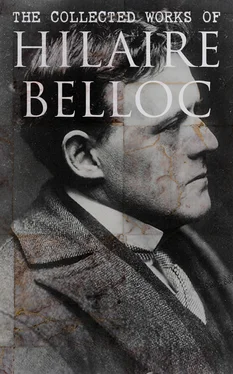1.From which little place the lines as a whole take the name in history of “Lines of La Bassée.”
2.As is common in the history of military affairs, the advocates of either party present these confused movements before the lines of La Bassée upon the eve of the siege of Tournai in very different and indeed contradictory lights.
The classical work of Mr. Fortescue, to which I must, here as elsewhere, render homage, will have the whole movement, from its inception, to be deliberately designed; no battle intended, the siege of Tournai to be the only real object of the allies.
The French apologists talk of quarrels between Eugene and Marlborough, take for granted a plan of assault against Villars, and represent the turning off of the army to the siege of Tournai as an afterthought. The truth, of course, is contained in both versions, and lies between the two. Eugene and Marlborough did intend a destructive assault upon Villars and his line, but they were early persuaded—especially by the reconnoitring of Cadogan—that the defensive skill of the French commander had proved formidable, and we may take it that the determination to besiege Tournai and to abandon an assault upon the main of the French forces had been reached at least as early as the 26th. There is no positive evidence, however, one way or the other, to decide these questions of motive. I rely upon no more than the probable intention of the men, to be deduced from their actions, and I do not believe that the Dutch would have had orders to move as early as they did unless Marlborough had decided—not later than the moment I have mentioned—to make Tournai the first objective of the campaign.
3.Mr. Fortescue in his work makes it the 23rd. I cannot conceive the basis for such an error. The whole story of the 24th, 25th, 26th, 27th, 28th, and 29th is in the French archives, together with full details of the capitulation on the 29th and 30th.
4.As usual, there is a contradiction in the records. The French record definitely ascribes the proposal to Marlborough. Marlborough, in a letter to his wife of 5th August, as definitely ascribes it to Surville; and there is no positive evidence one way or the other, though Louis’ rejection of the terms and the ability of calculation and the character of the two men certainly make it more probable that Marlborough and not Surville was the author of the proposition.
5.The dispute as to who was the author of the suggestion for an armistice is further illumined by this refusal on the part of the allies. The proposal to contain Tournai and yet to have free their vast forces in operation elsewhere, if a trifle crude, was certainly to their advantage, and as certainly to the disadvantage of the French.
6.This excellent phrase is Mr. Fortescue’s.
7.Technically the line of defence was forced, for the line of Trouille was but a continuation of the lines of La Bassée—Douai—Valenciennes. So far as strategical results were concerned, the withdrawal of Villars behind the forest barrier was equivalent to the reconstruction of new lines, and in the event the action of Malplaquet proved that new defensive position to be strong enough to prevent the invasion of France. On the other hand, there is little doubt that if Villars had been in a little more strength he would have elected to fight on the old lines and not behind the woods.
It must further be remarked that if the operations had not been prolonged as they were by the existence of the posts on the lines, notably at St. Ghislain, the defensive position of the French would probably have been forced and their whole line broken as early as September 4th.
8.It is remarkable that these two roads, which are the chief feature both of the landscape and the local military topography, and which are of course as straight as taut strings, are represented upon Mr. Fortescue’s map (vol. i. p. 424) as winding lanes, or, to speak more accurately, are not represented at all. In this perhaps the learned historian of the British army was misled by Coxe’s atlas to Marlborough’s campaign, a picturesque but grossly inaccurate compilation. The student who desires to study this action in detail will do well to consult the Belgian Ordnance Map on the scale of 1⁄40,000 contours at 5 metres, section Roisin, and the French General Staff Map, 1⁄80,000, section Maubeuge, south-western quarter; the action being fought exactly on the frontier between Belgium and France, both maps are necessary. For the general strategic position the French 1⁄200,000 in colours, sheet Maubeuge, and the adjoining sheet, Lille, are sufficient.
9.The reader who may compare this account of Malplaquet with others will be the less confused if he remembers that the forest of Sars is called on that extremity nearest to the gap the wood of Blaregnies, and that this name is often extended, especially in English accounts, to the whole forest.
10.These 9000 found at St. Ghislain a belated post of 200 French, who surrendered. Someone had forgotten them.
11.For the discussion of this see later on p. 75.
12.They were commanded by Hamilton and Tullibardine. It is to be remarked that the command of the whole of the left of the Prince of Orange’s force, though it was not half Scotch, was under the command of Hamilton and Douglas. The two regiments of Tullibardine and Hepburn were under the personal command of the Marquis of Tullibardine, the heir of Atholl.
13.Nominally under Tilly, but practically under the young Royal commander.
14.Villars, wounded and fainting with pain, had been taken from the field an hour or two before, and the whole command was now in the hands of Boufflers.
Table of Contents
Table of Contents
Introduction
Part I. The Campaign
Part II. The Preliminaries of the Action
Part III. The Terrain
Part IV. The Action
Part V. The Aspect of These Battles
Part VI. The Results of the Battle
Table of Contents
The Battle of Poitiers was fought ten years and four weeks after that of Crécy.
The singular similarity between the two actions will be pointed out upon a later page. For the moment it must suffice to point out that Poitiers and Crécy form unique historical parallels, distinguishing like double summits the English successes of Edward III.’s army upon the Continent and of the first part of the Hundred Years’ War.
For the political situation which had produced that conflict, and for the objects which Edward III. had in provoking it, I must refer my reader to the first section of my little book upon Crécy in this series; as also for the armament and organisation of the forces that served the English crown. There remain to be added, however, for the understanding of Poitiers and its campaign, two features which differentiate the fighting of 1356 from that of ten years before. These two features are: first, the character of the commander; and secondly, the nature of the regions from which he started and through which he proceeded, coupled with the political character of the English rule in the South of France. I will take these points in inverse order.
When Calais had fallen and had become an English possession in the summer of 1347 no peace followed. A truce was patched up for some months, followed by further truces. Through the mediation of the Pope a final and definite treaty was sketched, which should terminate the war upon the cession of Aquitaine to Edward III. in full sovereignty. The French Valois king would perhaps have agreed to a settlement which would have preserved his feudal headship, though it would have put the Plantagenets in virtual possession of half France (as France was then defined). But Edward III. would not accept the terms. He had claimed the crown of France. He had won his great victory at Crécy still claiming that crown. He would not be content with adding to his feudal tenures under the French crown. He would add to his sovereignty at least, to his absolute sovereignty , or continue the war. In 1354 (the Black Death intervening) the war was renewed. Edward would have been content, not with the whole of Aquitaine, but with complete sovereignty over the triangle between the Garonne and the Pyrenees in the south, coupled with complete sovereignty over the north-eastern seaboard of France from the Somme to Calais, and inland as far as Arras, and its territory, the Artois. But the French monarchy, though ready to admit feudal encroachments, would not dismember the nominal unity of the kingdom: just as a stickler in our north will grant a 999-year lease , but will not sell .
Читать дальше












